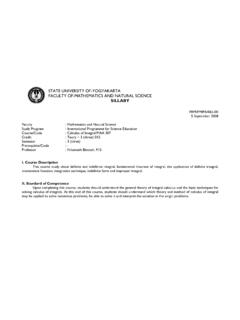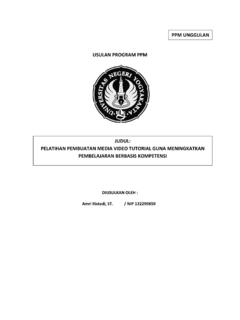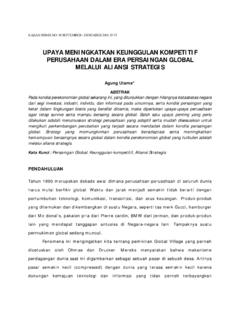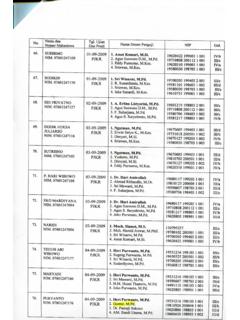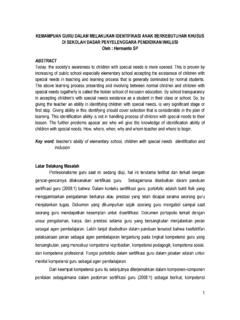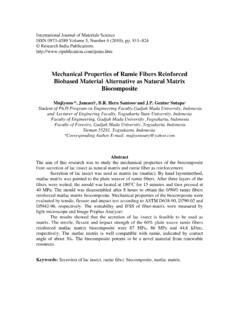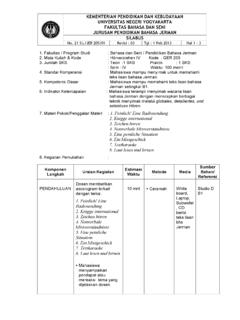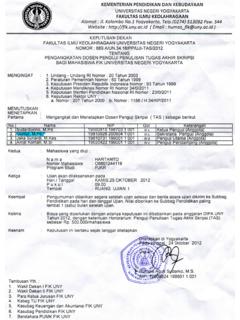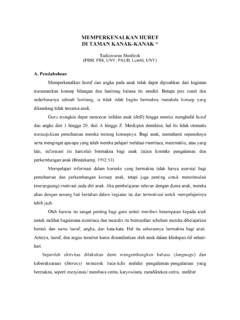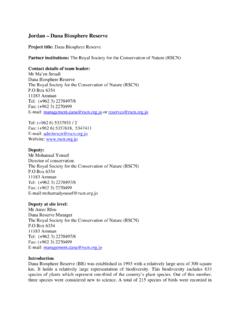Transcription of Exploring Science Making Models Interfering Making and ...
1 Exploring ScienceMaking ModelsInterferingMaking and Interpreting graphHeruHeru KuswantoKuswantoMaking and Interpreting graphExploring ScienceExploring ScienceDensity and Floating Eggs Problem : How can you use an egg to compare densities of liquids? about a cup of water in a about a cup of water in a jar2. Put the egg in the water. In a table like the one below, describe the position of the egg in the water3. Remove the egg. Put a spoonful of salt in the water and stir. Repeat step Repeat step 3. Add two and then two more spoonfuls of salt. Record your observationDensity ond Floating EggsDensity ond Floating Eggs Recording DataAmount of salt in waterPosition of eggNone1 spoonful3 spoonful5 spoonfulDensity ond Floating EggsDensity ond Floating Eggs Drawing conclusions1. How did the way of the egg floats change as the amount of salt in the water change? which stage war the water the most which stage war the water the most dense?
2 The least dense? How can you tell?Materials : egg (uncooked), water, large jar, salt, spoonMaking ModelsMaking Models How can you show convection? Steps1. Fill the large jar half full of cold the small jar with hot water. Add food the small jar with hot water. Add food coloring. Cover with plastic wrap. Seal with a rubber band. With a pencil point, poke a hole in the plastic wrap Lower the small jar of colored water into the jar of cold water. The small jar must be under water. Observe what can you show convection?How can you show convection? Questions1. What happened after you lower the small jar into the cold water? What could have caused this to happen?caused this to happen?2. What does this activity tell you about the movement of heat energy?InferringInferring Why does the temperature change? Steps1. Put 30 milliliters of cool water in a foam cup and 30 milliliters in a metal can.
3 The water in and 30 milliliters in a metal can. The water in both containers should be the same Put both containers in a pan of hot water. Put one thermometer in the cup and one in the can. Every minute for five minutes, measure and record the does the temperature Why does the temperature change?change? Questions1. How did the temperature of the water in the cup and the can differ?2. What does this activity indicate about heat movement and insulation?movement and insulation? Materials: plastic foam cup, metal can, hot and cool water, 2 thermometers, foil pie pan, measuring cup, clock or watch to measure secondsMaking and interpreting graphsMaking and interpreting graphs Marble motion1. On a level floor or a table top about m long, place a 30 cm metric ruler at an inclined of about cm. Use a book at one end of the ruler to raise a marble down the a marble down the incline3.
4 Record the distance the marble rolls from the bottom of the incline along the table top or floor in two seconds. Repeat this procedure two more Record the distance the marble rolls in three seconds, again Making three On the basis of your observation,a. Make a distance time graph of the marbleb. What is the average distance the marble rolls in two seconds? What is its average speed?c. What is the average distance the marble rolls in the third second? What is its average speed the third second? What is its average speed during that second?d. How does the speed during the third second compare with the speed during the first two seconds?e. How can you explain the change in speed?Fluid Density LevelsFluid Density Levels This experiment shows how different materials have different densities. In this case honey is placed on the bottom, water is placed above that, vegetable oil next and finally rubbing alcohol.
5 This mixture creates four levels of fluids alcohol. This mixture creates four levels of fluids having different densities. If the mixture is then shaken, the fluids mix and the water, alcohol and honey form a layer and the oil forms a separate layer thus changing how the system looks. EquipmentHoney Water Olive/Veg OilRubbing Alcohol Food Coloring Graduated CylinderTesting the Strength of an Testing the Strength of an Ordinary EggOrdinary EggTesting the Strength of an Testing the Strength of an Ordinary EggOrdinary Egg Everybody knows how easy it is to break an egg, because of its very thin shell. Today our young scientists learned that an egg can also be very strong. Nature made it to be both light and strong, so that it can withstand the impact of falling to the ground when the egg is laid. We talked about the properties of an egg: it is round, light, smooth and white.
6 The children were asked to hypothesize (make a scientific guess) about the egg's strength. Is an egg strong and powerful, or weak and fragile? strength. Is an egg strong and powerful, or weak and fragile? five students said the egg was strong and powerful eleven students said the egg was weak and fragile. To find out the answer to our question, we carefully placed the uncooked, ordinary egg in some soft clay. Using the egg and the two blocks of wood, we made a triangular base to support a large, lightweight cookie sheet. We slowly added books, one by one, to see how much weight the egg could help support. Excitement was building as each book was placed on the stack. In the end, we found the egg to support sixty-six books: over twenty pounds! Why didn't the egg break sooner? The egg has an arch at each end, an excellent structure for supporting the Strength of an Testing the Strength of an Ordinary EggOrdinary EggTesting the Strength of an Testing the Strength of an Ordinary EggOrdinary EggOctober 31, 2000: Testing the October 31, 2000: Testing the Strength of an Ordinary EggStrength of an Ordinary Egg
